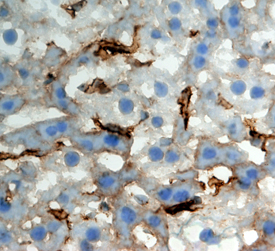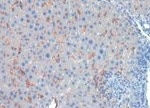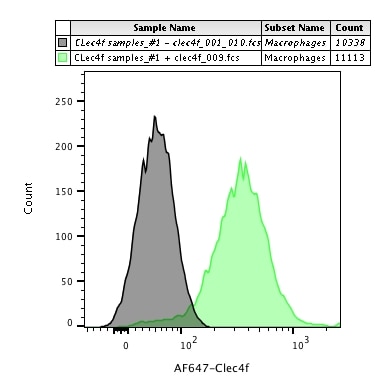Mouse CLEC4F/CLECSF13 Antibody Summary
Ala65-Gly548
Accession # P70194
Applications
Please Note: Optimal dilutions should be determined by each laboratory for each application. General Protocols are available in the Technical Information section on our website.
Scientific Data
 View Larger
View Larger
CLEC4F/CLECSF13 in Mouse Liver. CLEC4F/CLECSF13 was detected in perfusion fixed frozen sections of mouse liver using Rat Anti-Mouse CLEC4F/CLECSF13 Monoclonal Antibody (Catalog # MAB2784) at 5 µg/mL overnight at 4 °C. Tissue was stained using the Anti-Rat HRP-DAB Cell & Tissue Staining Kit (brown; Catalog # CTS017) and counterstained with hematoxylin (blue). Specific staining was localized to Kupffer cells. View our protocol for Chromogenic IHC Staining of Frozen Tissue Sections.
Reconstitution Calculator
Preparation and Storage
- 12 months from date of receipt, -20 to -70 °C as supplied.
- 1 month, 2 to 8 °C under sterile conditions after reconstitution.
- 6 months, -20 to -70 °C under sterile conditions after reconstitution.
Background: CLEC4F/CLECSF13
CLEC4F (C-type lectin domain; family 4, member F; also known as the Kupffer cell receptor and fucose receptor) is an 80 kDa, type II transmembrane glycoprotein member of the C-type lectin superfamily (1‑3). Mature mouse CLEC4F consists of a 42 amino acid (aa) cytoplasmic domain, a 27 aa transmembrane segment, and a 479 aa extracellular domain (ECD) that contains an extended stalk region plus one carbohydrate recognition domain (4, 5). Within the ECD, mouse CLEC4F shares 48% and 79% aa sequence identity with human and rat CLEC4F, respectively. The stalk region of CLEC4F is a coiled coil domain that mediates homotrimer formation (6, 7). CLEC4F is expressed on Kupffer cells in the liver, but not on macrophages in other tissues (8). CLEC4F preferentially binds galactose and N‑acetylgalactosamine in a calcium-dependent manner (6, 9, 10). Its activity at neutral, but not at acidic pH, suggests a capacity to internalize and release ligands into the endosomal system (11).
- Zelensky, A.N. and J.E. Gready (2005) FEBS J. 272:6179.
- Bilzer, M. et al. (2006) Liver Int. 26:1175.
- Kuiper, J. et al. (1994) Biochem. J. 299:285.
- Accession # P70194.
- Hoyle, G.W. and R.L. Hill (1988) J. Biol. Chem. 263:7487.
- Fadden, A.J. et al. (2003) Glycobiology 13:529.
- Beavil, A.J. et al. (1992) Proc. Natl. Acad. Sci. 89:753.
- Haltiwanger, R.S. et al. (1986) J. Biol. Chem. 261:7433.
- Coombs, P.J. et al. (2006) Glycobiology 16:1C.
- Biessen, E.A.L. et al. (1994) Biochem. J. 299:291.
- Lehrman, M.A. et al. (1986) J. Biol. Chem. 261:7426.
Product Datasheets
Citations for Mouse CLEC4F/CLECSF13 Antibody
R&D Systems personnel manually curate a database that contains references using R&D Systems products. The data collected includes not only links to publications in PubMed, but also provides information about sample types, species, and experimental conditions.
5
Citations: Showing 1 - 5
Filter your results:
Filter by:
-
Characteristic gene expression in the liver monocyte-macrophage-DC system is associated with the progression of fibrosis in NASH
Authors: Wang X, Wang Z, Liu B et al.
Frontiers in Immunology
-
Kupffer cell receptor CLEC4F is important for the destruction of desialylated platelets in mice
Authors: Y Jiang, Y Tang, C Hoover, Y Kondo, D Huang, D Restagno, B Shao, L Gao, J Michael Mc, M Zhou, R Silasi-Man, S McGee, M Jiang, X Bai, F Lupu, C Ruan, JD Marth, D Wu, Y Han, L Xia
Cell Death and Differentiation, 2021-05-15;0(0):.
Species: Mouse
Sample Types: Whole Tissue
Applications: IHC -
In vivo liposomal delivery of PPARalpha/gamma dual agonist tesaglitazar in a model of obesity enriches macrophage targeting and limits liver and kidney drug effects
Authors: V Osinski, DK Bauknight, SSK Dasa, MJ Harms, T Kroon, MA Marshall, JC Garmey, AT Nguyen, J Hartman, A Upadhye, P Srikakulap, A Zhou, G O'Mahony, AL Klibanov, KA Kelly, J Boucher, CA McNamara
Theranostics, 2020-01-01;10(2):585-601.
Species: Mouse
Sample Types: Whole Tissue
Applications: IHC -
Adipocyte Death Preferentially Induces Liver Injury and Inflammation Through the Activation of Chemokine (C-C Motif) Receptor 2-Positive Macrophages and Lipolysis
Authors: Seung-Jin K, Dechun F, Adrien G et al.
Hepatology.
-
Lipopolysaccharide Lowers Cholesteryl Ester Transfer Protein by Activating F4/80+Clec4f+Vsig4+Ly6C- Kupffer Cell Subsets
Authors: SJL van der Tu, Z Li, JFP Berbée, I Verkouter, LE Ringnalda, AE Neele, JB van Klinke, SS Rensen, J Fu, MPJ de Winther, AK Groen, PCN Rensen, K Willems va, Y Wang
J Am Heart Assoc, 2018-03-10;7(6):.
Species: Mouse
Sample Types: Whole Tissue
Applications: IHC
FAQs
No product specific FAQs exist for this product, however you may
View all Antibody FAQsReviews for Mouse CLEC4F/CLECSF13 Antibody
Average Rating: 4.5 (Based on 2 Reviews)
Have you used Mouse CLEC4F/CLECSF13 Antibody?
Submit a review and receive an Amazon gift card.
$25/€18/£15/$25CAN/¥75 Yuan/¥2500 Yen for a review with an image
$10/€7/£6/$10 CAD/¥70 Yuan/¥1110 Yen for a review without an image
Filter by:



